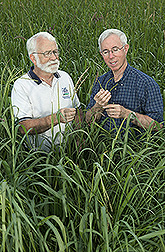Eastern Gamagrass May Be Queen of Carbon Storage
|
|
There’s good news for those interested in finding plants that would do best at storing carbon in the warmer world predicted because of rising levels of carbon dioxide (CO2) and other greenhouse gases. Not only would plants that thrive under such conditions provide higher yields, but their ability to store added carbon would help offset higher atmospheric CO2 levels.
Scientists at the Henry A. Wallace Beltsville (Maryland) Agricultural Research Center are simulating global warming conditions in outdoor climate-controlled SPAR (soil-plant-atmosphere research) chambers. Their experiments show that by increasing day and night temperatures each by 27˚F, eastern gamagrass plants could store three times as much carbon. At the temperatures they used, the hotter it got, the more the grass leaves grew and the more carbon they stored.
Eastern gamagrass is often called “Queen of the Grasses” because it has so many good qualities. It is a hardy, warm-season grass that grows well in marginal soils—those that are acidic, compact, and sometimes flooded. It can grow in soil with limited moisture because of its ability to send roots deep into the soil to tap water there. And it provides high yields of forage as nutritious as alfalfa at a time when cool-season grasses go dormant. The grass can also be used as a conservation planting and has potential as a bioenergy crop.
In this study, ARS plant physiologists Don Krizek, Dennis Gitz, and V.R. Reddy and soil scientist Jerry Ritchie obtained the first experimental proof that eastern gamagrass may outcompete other plants and store more carbon in a hotter climate.
They did this by growing eastern gamagrass in six SPAR chambers. Three chambers contained current CO2 atmospheric levels of 370 parts per million, while the other three had double that level—the rate expected after 2100.
At each CO2 level, one chamber was kept at day/night temperatures of 68˚F/57˚F, another at 81˚F/71˚F, and the third at 95˚F/84˚F.
Temperature had far more effect than CO2 level on plant growth. The highest day/night temperature (95˚F/84˚F) proved best for leaf growth, while the intermediate day/night temperature regime (81˚F/71˚F) was best for root growth. The leaves were darker green at the higher temperatures, indicating greater thickness and more chlorophyll. They also stored twice as much nitrogen, which increased the protein content.
“Elevated CO2 did not stimulate root growth as is often found in other crops,” Krizek says, “but that could change in other experiments if eastern gamagrass plants are not well watered or are grown in different soils. These plants should do better under hot, dry conditions because they can close the stomates on their leaves during the day, thereby reducing water use.”—By Don Comis, Agricultural Research Service Information Staff.
This research is part of Global Change (#204) and Integrated Agricultural Systems (#207), two ARS National Programs described on the World Wide Web at www.nps.ars.usda.gov.
Donald T. Krizek is with the USDA-ARS Sustainable Agricultural Systems Laboratory, 10300 Baltimore Ave., BARC-West, Beltsville, MD 20705-2350; phone (301) 504-5324, fax (301) 504-8370.
"Eastern Gamagrass May Be Queen of Carbon Storage" was published in the September 2005 issue of Agricultural Research magazine.







